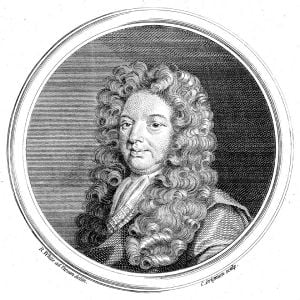John Blow
John Blow (1649 – October 1, 1708) was an English composer and organist. His pupils included William Croft and Henry Purcell.
Blow was probably born at North Collingham in Nottinghamshire. He became a chorister of the Chapel Royal, and distinguished himself by his proficiency in music.
Biography
He composed several anthems at an unusually early age, including Lord, Thou host been our refuge, Lord, rebuke me not and the so-called "club anthem," I will always give thanks, the last in collaboration with Pelham Humfrey and William Turner, either in honor of a victory over the Dutch in 1665, or more probably simply to commemorate the friendly interrelationships between the three choristers.
To this time also belongs the composition of a two-part setting of Robert Herrick's Goe, perjur'd man, written at the request of Charles II to imitate Giacomo Carissimi's Dite, o cieli. In 1669 Blow became organist of Westminster Abbey. In 1673 he was made a gentleman of the Chapel Royal and in the September of this year he married Elizabeth Braddock, who died in childbirth ten years later.
Blow, who by 1678 was a doctor of music, was named in 1685 one of the private musicians of James II. Between 1680 and 1687 he wrote his only stage composition of which any record survives, the Masque opera for the entertainment of the King, Venus and Adonis. In this Mary Davies played the part of Venus, and her daughter by Charles II, Lady Mary Tudor, appeared as Cupid.
In 1687 he became master of the choir of St Paul's Cathedral; in 1695 he was elected organist of St. Margaret's, Westminster, and is said to have resumed his post as organist of Westminster Abbey, from which in 1680 he had retired or been dismissed to make way for Purcell. In 1699 he was appointed to the newly created post of Composer to the Chapel Royal. Blow died on October 1 1708 at his house in Broad Sanctuary, and was buried in the north aisle of Westminster Abbey.
Musical Accomplishments
Fourteen services and more than a hundred anthems by Blow are known. In addition to his purely ecclesiastical music Blow wrote Great sir, the joy of all our hearts, an ode for New Year's Day 1682, similar compositions for 1683, 1686, 1687, 1688, 1689, 1693 (?), 1694 and 1700; odes, and the like, for the celebration of St Cecilia's Day for 1684, 1691, 1695 and 1700; for the coronation of James II, two anthems, Behold, O God, our Defender and God spake sometimes in visions; some harpsichord pieces for the second part of Henry Playford's Musick's handmaid (1689); Epicedium for Queen Mary (1695) and Ode on the Death of Purcell (1696). In 1700 he published his Amphion Anglicus, a collection of pieces of music for one, two, three and four voices, with a figured bass accompaniment. A famous page in Charles Burney's History of Music is devoted to illustrations of Blow's "crudities," most of which only show the meritorious if immature efforts in expression characteristic of English music at the time, while some of them (where Burney says "Here we are lost") are really excellent.
ReferencesISBN links support NWE through referral fees
- Blow, John; Wood, Bruce, Anthems with Orchestra, London: Stainer and Bell; NY: Galaxy Music Corp., 1978. ISBN 0-852-49446-7
- Dart, Thurston; Moroney, Davitt, John Blow's Anthology, London: Stainer and Bell. NY: Galaxy Music Corp., 1978. ISBN 0-852-49446-7
- Oberlin, Russell; Bressler, Charles; Krainis, Bernard, et al, Music of John Blow and Henry Purcell, Pleasantville, NY: VAI Audio, 2006. OCLC 76785825
External Links
- http://www.recmusic.org/lieder/b/blow.html Retrieved May 22, 2007.
- http://www.hoasm.org/VIIA/Blow.html Retrieved May 22, 2007.
- http://www.britannica.com/eb/article-9015736/John-Blow Retrieved May 22, 2007.
Credits
New World Encyclopedia writers and editors rewrote and completed the Wikipedia article in accordance with New World Encyclopedia standards. This article abides by terms of the Creative Commons CC-by-sa 3.0 License (CC-by-sa), which may be used and disseminated with proper attribution. Credit is due under the terms of this license that can reference both the New World Encyclopedia contributors and the selfless volunteer contributors of the Wikimedia Foundation. To cite this article click here for a list of acceptable citing formats.The history of earlier contributions by wikipedians is accessible to researchers here:
The history of this article since it was imported to New World Encyclopedia:
Note: Some restrictions may apply to use of individual images which are separately licensed.
